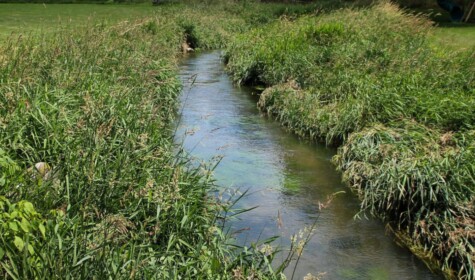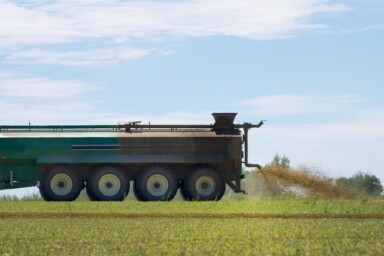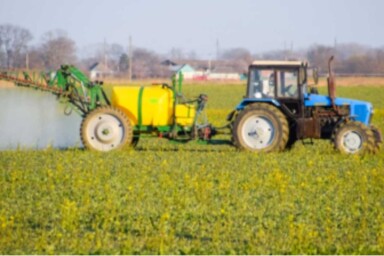The journey of an agricultural pollutant from its source, along its flow path (often in surface water flooding across fields), to its end destination, where it has the potential to do damage to the natural environment, is an essential concern of Catchment Sensitive Farming officers (CSFOs) on every farm they advise. Understanding how pollutants manifest on a farm, and the journey they subsequently take into the surrounding environment, enables farm advisers including CSFOs to evaluate how to address water and air pollution from agriculture.
Successful reduction of this diffuse pollution from food production can best be achieved by the adoption of practices which stop nutrients or pesticides becoming a pollutant in the first place. This not only has benefits for the environment but also for the farmer who saves money by wasting fewer inputs. Inevitably though, some agricultural inputs (such as fertiliser and manure) escape down a field or out of a livestock shed. Here, measures to intercept the errant material along its flow path come into play.
To mitigate this, a buffer strip of grassland and trees protecting a river or a ditch from waterborne nitrates or a shelterbelt of trees trapping ammonia emanating from a poultry house are just two examples of how Catchment Sensitive Farming is helping farms to address such diffuse pollution. And in flood prone areas of farmland, these practices can also help slow the flow of surface water encountered during storm events, enough to reduce the worst of its impact further down river catchments.
It takes careful consideration of each field and cropping rotation, each hedge or drystone wall boundary, farm track and gateway for the full benefits of Catchment Sensitive Farming to be realised. Farm advice is key and input from a Catchment Sensitive Farming officer is required to implement measures which are potentially available as funded options through the mid-tier of the English Countryside Stewardship scheme. To make the most of what funding is available, only farms in the highest priority areas for measures addressing air and water pollution are currently eligible to apply for funding.
Water and agri-food companies such as those involved in WRAP’s ‘Courtauld Commitment 2025’, are increasingly interested in encouraging farmers to apply measures that address water pollution. It makes sense for Catchment Sensitive Farming and other government farm advice initiatives to work in close partnership with private sector interests and their delivery partners and NGOs, like the Sustainable Food Trust.
The Sustainable Food Trust came to our attention three years ago, when we worked with Adele Jones on the ground-breaking Harmonised Farm Sustainability Metrics project. We invited Adele to deliver a keynote speech at our first ‘Catchment Sensitive Farmers Partners Conference’ back in November 2019. The Sustainable Food Trust presentation went down so well with delegates, we invited Adele and her team to help deliver our ambitious two-day online CSF Partners’ Conference for 2020 on the theme of Measuring, Managing and Delivering Transformational Change on Farms. Despite all that was thrown at us pandemic-wise, the Conference was a success. Keynote presentations from Tony Juniper, Natural England’s Chair and Patrick Holden, Sustainable Food Trust’s Chief Executive at the event can be viewed below.
- The e-Conference included much consideration and debate on the role of trees on farm, particularly with respect to helping to address water issues including water pollution, drought and flood mitigation. An excellent break out session led by John Tucker from the Woodland Trust on agro-forestry brought the role of trees in sustainable food production into sharp focus. As International Day of Forests (21st March) and World Water Day (22nd March) approach, it is worth reflecting on some of the messages from the session. Any mix of trees in a farm setting should be thought of as agro-forestry.
- Clear objectives and careful consideration of the role trees are playing, are important for best results.
- Trees can make important contributions to agricultural soil health such as scavenging of surplus nutrients and improving the hydrology of soils with their root systems.
- Agro-forestry is about trees increasing the productivity of sustainable food production on farms.
- Hedges are very much part of this mix, providing sources of pollen for crop production and shelter for livestock as well as intercepting and cleaning surface water.
- The separation of the disciplines of forestry and agriculture have hindered effective integration of trees into farm systems. The need to train more farm advisers in agro-forestry techniques is an important action for CSF to help take forward.
The role of trees in addressing pollution and ensuring clean water and healthy soil cannot be underestimated. This highlights the way all components of a farm are interconnected and must be viewed holistically. When assessing pollution and sustainability, we therefore must assess the whole system. I look forward to a time when the sustainability of every farm is accounted for through a clear, unified system of annual assessment which is communicated across supply chains and across continents.
Photograph credit.





